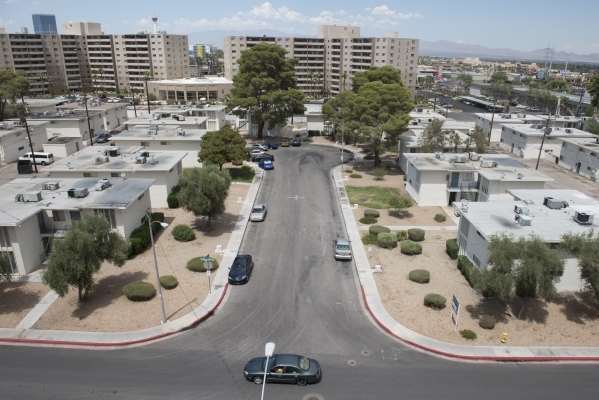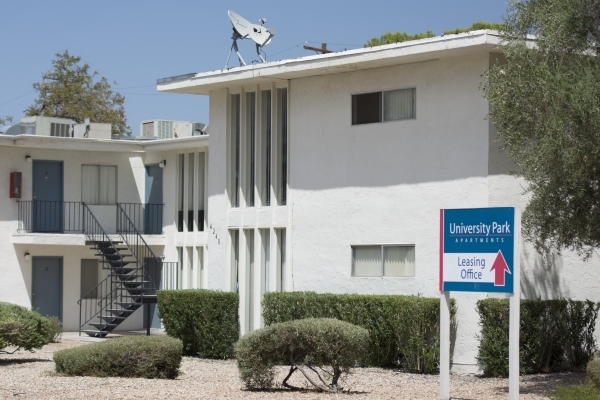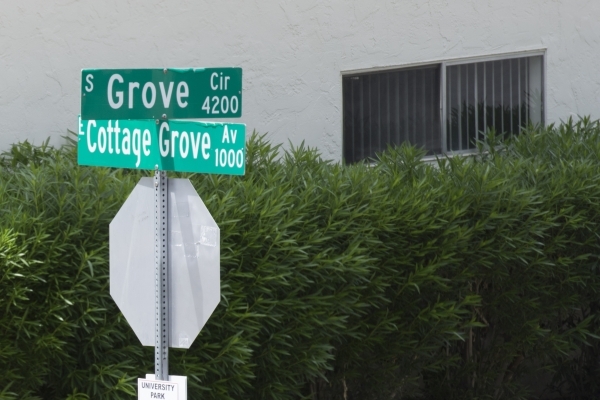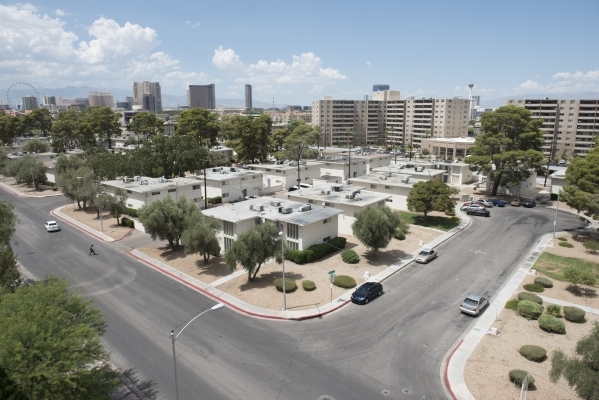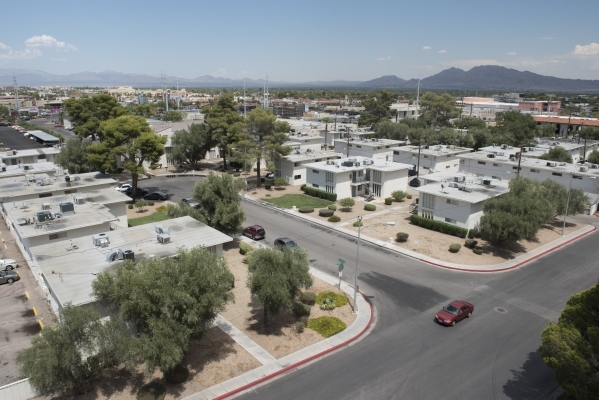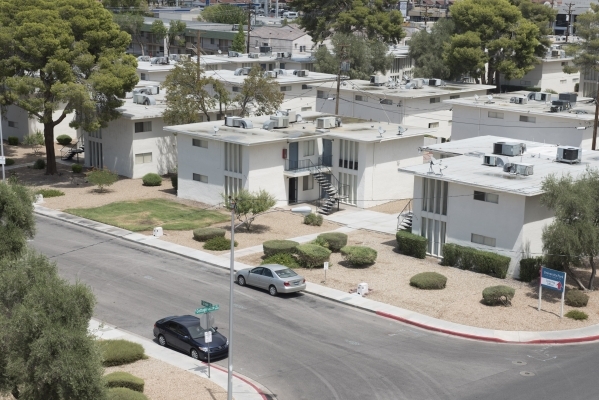UNLV working to remove ‘commuter campus’ label
Just east of this desert city's gleaming resort corridor, the University of Nevada, Las Vegas anchors a hardscrabble stretch of Clark County with early signs of college life.
Backpack-toting students share crowded sidewalks with homeless people pushing shopping carts along Maryland Parkway, where shabby apartment buildings are tucked between retail plazas like College Town and University Gardens.
The 332-acre campus, nestled in the heart of a big city teeming with entertainment options, has the trappings of a major university — Greek life, intercollegiate sports and student housing.
Yet despite all it offers, UNLV has struggled for decades to shed its image as a sleepy commuter school. Only last fall did it manage to fill its dormitory halls to capacity, squeezing 6 percent of its students onto the campus. That leaves UNLV lagging far behind the University of Nevada, Reno, where 17 percent of students live in campus housing.
"It would be nice if me and my sorority sisters could live together here," said Lora Wulff, a UNLV freshman who lives about 25 miles from the campus, in the north valley.
Wulff wants to move closer to school, but housing is scarce and it's hard to live there anyway without having to drive elsewhere for necessities and errands.
"From what I've heard, in other colleges in other states you can actually walk places," said Wulff, 18. "It would be pretty cool if it were like that here, but it probably won't happen."
According to an assessment of student housing trends by U.S. News & World Report, the average percentage of undergraduate students at traditional research universities who lived on campus in 2013 was 39 percent. UNLV was one of three institutions that reported 5 percent, the lowest average. The other two schools were the University of Colorado, Denver, and the University of Texas, San Antonio.
At 99 percent, Harvard University in Massachusetts had the highest percentage of students living on campus in 2013. Data for the survey were submitted by 252 ranked schools.
GOING RESIDENTIAL
UNLV administrators have spent the past four years trying to transform the school and its surrounding neighborhood into a more inviting home for students like Wulff. They've had some success, more than doubling the number of tenants living in the university's four dormitories, which open to new residents on Wednesday and to returning residents on Friday .
The push began in early 2011, when administrators realized all four dormitories at UNLV were only half full because employees weren't adequately recruiting tenants. Officials hired a private company to manage the properties, and last fall all four dorms were above capacity with 1,750 students in residence, said Gerry Bomotti, UNLV's senior vice president for finance and business.
"When I started more than 20 years ago, there was hardly anyone living on campus, and I would say it was accurately portrayed as a commuter campus," said UNLV Senior Vice Provost Carl Reiber. "But now, with three-quarters of our students being full-time, we've gone through a radical transformation, and that's not by accident."
Officials believe that students who live near campus are more likely to take a full course load, boosting their chances of graduating. Plus, Reiber said, a traditional college experience leads to valuable networking among emerging professionals.
But change at UNLV has been slow and unsteady, halted in the late 2000s by an economic downturn that bruised enrollment levels. Now that the dorms are at full capacity and the school is recovering financially, higher education officials are trying to bolster UNLV's housing stock — a plan they put on hold before the nation's financial crisis hit Las Vegas and forced the campus to close its fifth dorm complex.
Intent on rejuvenating areas in and around the university, administrators have pursued at least three major partnerships with private investors to build new apartments and retail space for students. Two of those ventures have failed due to financing problems.
The first, dubbed UNLV Now, was a $900 million project proposed by a university consultant in 2012 to create a stadium complex with apartments, retail space and dorms with up to 5,000 beds in the southwest corner of the campus. It was scrapped the following year.
The second proposal was called Midtown Park, a $175 million apartment-style dormitory project tentatively approved in early 2013 by state education officials. It was scheduled to open this fall, replacing the aging, privately owned University Park Apartments complex at Maryland Parkway and Cottage Grove Avenue. But that plan also was ended in 2013.
The current plan restarts efforts to develop University Park. Through a partnership with Seattle-based real estate firm Midby Companies, UNLV plans to spend $18.5 million to purchase a 6-acre stretch of that plot, while Midby will finance and manage a new apartment complex built at the site.
The Nevada Board of Regents in April approved a funding plan for the deal, and although the company has declined to specify how much it wants to invest in the property, Bomotti said tentative plans indicate Midby could house at least 740 students as early as 2017. Within the next decade, UNLV hopes the company can create enough space for 3,000 beds.
PRIVATE PARTNERSHIPS
UNLV has increasingly turned to the private sector to develop and even manage housing off the campus — officials say this lets the school dedicate most of its funding to academic buildings and facilities. The school is working with another private company to develop a parking structure across from Greenspun Hall, near Maryland Parkway and University Road.
"The private sector does a great job, really," Bomotti said. "Sometimes they're better able to manage some of these activities that aren't core to our university mission."
Sensing demand, some privately owned apartment complexes around the school market and cater to students even though they aren't affiliated with UNLV.
At Rebel Place, located at 3896 Swenson St., about half a mile north of the campus, students can take a courtesy shuttle to and from the campus every 20 minutes during the regular school year. There are 24-hour study rooms, and each bedroom inside the complex is furnished with desks.
"We also offer them snacks during finals," said Geena White-Arbizo, the property's assistant manager. "We try to make things very convenient for them."
SEPARATE INTERESTS
Public-private partnerships can have many benefits, but they can be risky because schools put themselves at the mercy of a company's bottom line, education experts warn.
"Any time you engage the private sector, you should remember that they expect to make a profit," said Doug Priest, an associate professor emeritus of higher education at Indiana University and co-editor of "Privatization and Public Universities," published in 2006.
"Universities are trying to protect students, but private institutions are trying to protect their profit," Priest said.
The integrity of a student housing facility also can be compromised if it isn't managed directly by school officials, said Jerome Maese, director of residential life at UNR. Staff members at the Reno campus supervise students at all eight housing facilities, including Ponderosa Village, a residence hall for graduate students that is partially funded by a private investor.
UNR houses 3,300 students who live there on the condition that they maintain satisfactory grades. The school's emphasis on academic performance at student housing facilities is what lures many there, Maese said. Those living on campus have better access to tutoring services, and they even get rent specials for having a high GPA.
"The problem that you have when a facility isn't university-operated, for us, is that you can't have academic standards and grade checks and enrollment checks," Maese said in a July interview. "And when we knock on someone's door with a violation, we have the authority of the university, not just a landlord."
At UNLV — where housing options are vastly more limited — students are lucky if they can simply find a clean, affordable apartments within walking distance to class.
For instance, Han Bee Kim — a 21-year-old international student from Korea who is studying hospitality at UNLV — is eager to move a mile north from her home at the Rancho Alvarado Apartments to the Vegas Towers Apartments, even though the posh high-rise is farther from campus and will be considerably more expensive. Rancho Alvarado advertises rates as low as $525 per month, while Vegas Towers lists its lowest rent at $940.
Kim says it'll be worth it: "No cockroaches there."
Contact Ana Ley at aley@reviewjournal.com or 702-224-5512. Find her on Twitter @la__ley



